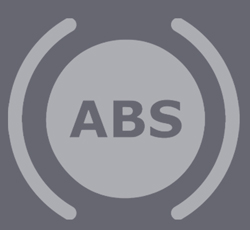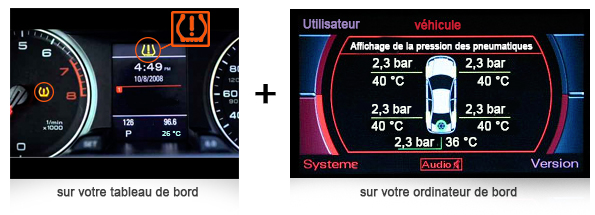Tyre Pressure Monitoring System (TPMS)
TPMS stands for Tyre Pressure Monitoring System.
It is a built-in electronic system that is used for monitoring the pressure in the tyres of your vehicle.
All types of new vehicles and approved camper van must be fitted with a TPM system, as of 1st November of 2012.
As of 1st November of 2014, all newly registered motor vehicles and camper van in the EU must have a TPM system installed.
Nevertheless, the TPM system is not specified by the European Directive. Thereby, direct and indirect systems are both authorised.
Both systems must be in line with ECE-R 64 specifications. ECE-R 64 specifications only state the function but do not require the sensor to be original or fitted.
Indirect system
An indirect TPMS uses the sensors of the Anti Lock Braking (ABS) system and
the front-wheel drive that controls the speed of each individual tyre.
In addition, the oscillations, dependent on the pressure of each wheel, are measured by the sensors.
Indirect TPMS does not measure tyre pressure or temperature.
Then, it can not detect the loss of pressure on a stationary vehicle.
No additional effort/cost when changing tyres since there are no sensors installed directly in the tyres.

Direct System
A direct TPMS allows for very accurate data collection and has additional functions such as tyre position recognition, pressure drop detection when the vehicle is parked and tyre pressure control of the spare wheel.
On direct control systems, a sensor located in the wheel
detects the pressure in the tyres.
This information is transmitted by a radio signal to the car's on-board computer.
Depending on the configuration of the on-board computer, the driver
can read the current pressure values on his screen and consult them by pressing a button.
A loss of pressure in all four tyres should automatically cause the TPMS to issue a warning to the driver.
These systems can identify sudden or gradual loss of pressure on all types of tires since they directly control the pressure.
A direct TPMS requires a significant additional effort and therefore an extra-cost when changing tyres or during their maintenance.
Whenever a tyre or wheel is changed after a new sensor is installed on the vehicle or a wheel position is changed, a new activation of the sensors is necessary to ensure communication between the sensors and the TPMS receiver.

HOW DO YOU KNOW IF THE VEHICLE IS EQUIPPED WITH TPMS VALVES?
As of November 2014, all registered vehicles must be equipped with either a direct (with pressure sensor valves : TPMS Valves) or an indirect (with software linked to the ABS) TPM system.
TO KNOW IF YOUR VEHICLE IS EQUIPPED WITH TPMS VALVES:
CHECK THE UNIVERSAL SYMBOL ON THE DASHBOARD (WHEN YOU TURN THE KEY)
+ THE REAL PRESSURE INDICATION OF EVERY ONE OF YOUR TYRES IN YOUR VEHICLE COMPUTER.

WHERE THESE TWO INDICATIONS ARE PRESENT ON YOUR VEHICLE,
YOU NEED TO ADD TPMS VALVES TO YOUR ORDER.